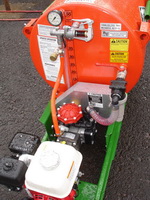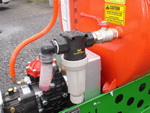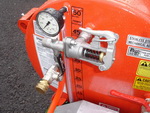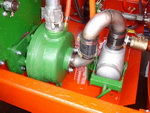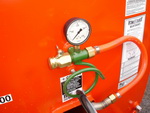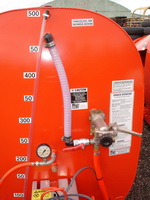Positive displacement pumps (diaphragm, roller and piston pumps)
1. Check that the pump is turning. A PTO driven pump is obvious but gas motor, electric motor or hydraulic motor drive pumps can be harder to check.
2. Make sure the dump valve is closed. This is the most common reason pressure is suddenly not being built. The dump valve should only be open when mixing chemical.
3. Check the relief valve. In the case of a bale type valve make sure the bale is latched and the pressure adjustment screw is set to pressure desired. If the valve does not have an engagement bale then make sure the valve is not "backed off". Make a couple clockwise turns of the handle to see if pressure changes.
4. If you have a diaphragm pump there will be an oil fill sight glass. Make sure the oil is not milky which would indicate a ruptured diaphragm.
5. Make sure the suction valve is open and the suction strainer screen is not clogged.
6. If there is spray being pumped and it appears it has some pressure but the gauge does not register or is wrong then the gauge may be bad. Pressure spikes caused by booms being turned on and off can damage a gauge over time.
7. If all else is correct then an internal inspection of the pump may be needed. The spring valves, diaphragms, rollers or other seals will need to be checked. Our parts department keeps a stock of common repair kits for all pumps we sell.
8. If electric valves are being used make sure the valve is receiving 12 volts and is actuating. An electric ball valve can be heard but removing the inlet hose and viewing the ball will confirm rotation.
9. If hydraulic valves are used then make sure hydraulic pressure is being supplied from the tractor. Make sure the tractor hydraulic oil reservoir is filled. Make sure the hoses are attached correctly for pressure and return sides. A 4000 psi pressure gauge can be added to the hydraulic plumbing to check pressure.
Centrifugal pumps
1. Check that the pump is turning. A PTO driven pump is obvious but gas motor, electric motor or hydraulic motor drive pumps can be harder to check.
2. Make sure the dump valve is closed. This is the most common reason pressure is suddenly not being built. The dump valve should only be open when mixing chemical or when priming the pump.
3. If there is a throttling valve in the plumbing make sure it is not completely shut.
4. Make sure the suction valve is open and the suction strainer screen is not clogged.
5. If there is spray being pumped and it appears it has some pressure but the gauge does not register or is wrong then the gauge may be bad. Pressure spikes caused by booms being turned on and off can damage a gauge over time.
6. If all else is correct then an internal inspection of the pump may be needed. The pump contains an impeller that can wear when spraying powders or coarse material. The carbon-ceramic shaft seals may need replacement.
7. If electric valves are being used make sure the valve is receiving 12 volts and is actuating. An electric ball valve can be heard but removing the inlet hose and viewing the ball will confirm rotation.
8. If hydraulic valves are used then make sure hydraulic pressure is being supplied from the tractor. Make sure the tractor hydraulic oil reservoir is filled. A 4000 psi pressure gauge can be added to the hydraulic plumbing to check pressure.
